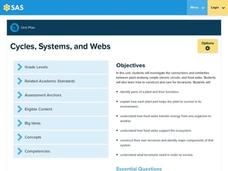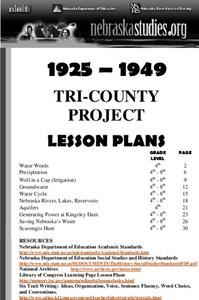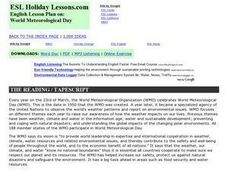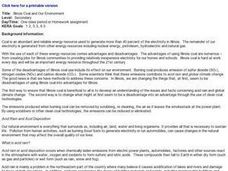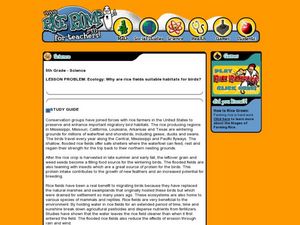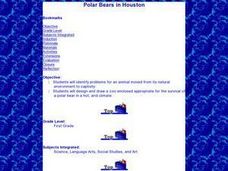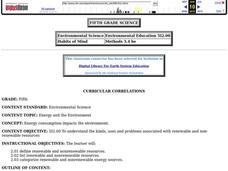Curated OER
Investigating a Fresh Fish
Fourth graders investigate the anatomy of a fish. In this adaptations lesson plan, 4th graders look at fresh fish and identify their adaptations and decide where they think the fish may live. Students draw and label the fish and its...
Pennsylvania Department of Education
Cycles, Systems, and Webs
Fourth graders review the parts of the plant and their functions. In this plant lesson plan, 4th graders recognize that plants must transfer energy to make food. Students understand the interdependence of organisms in an ecosystem.
Curated OER
Aquifers and Recharge Areas
Students create a model of an aquifer and describe how an aquifer works. They describe how running affects an aquifer and prepare a model presenting to local planners the important aspects of protecting recharge areas.
Curated OER
Air Pollution: Visible And Invisible
Fourth graders observe air pollution that is visible and invisible with experimentation. During the experiment the students collect data that needs analysis. The observations are recorded in the lab journal. The data also is represented...
Curated OER
Discover How Trees Produce and Conserve Energy
Students discover the flow of energy from plants to humans, the importance of this and how the energy chain is effected. In this informational lesson students will see how energy is produced and conserved by trees and how it can be...
Curated OER
Kamchatka: Just Gushing with Geysers!
Students explore geysers. They identify the parts of the geyser and how it works. Students create a working model of a geyser. They write a brief summary about their geyser.
Curated OER
The Miracle Fish: Learning to Design an Experiment
Learners develop procedures to explore the behavior of fish. In this scientific experiment lesson students from a hypothesis, write a question, identify different variables and controls in their experiment.
Curated OER
Scavenger Hunt
Students summarize the "Tri-County Project" section of the nebraskastudies.org web site using a scavenger hunt.
Curated OER
World Meteorological Day
In this World Meteorological Day worksheet, students read or listen to a passage, then match phrases, fill in the blanks, choose the correct word, unscramble words and sentences, put sentences in order, write discussion questions and...
Curated OER
The Lorax
Students read The Lorax and discuss how human actions can affect the environment. They conduct a simple experiment to see how much air pollution is in the air that they breathe.
Curated OER
Sustainable Agriculture
Students perform an experiment to find out if plants grow best when grown in soil with no fertilizer, with chemical fertilizers, or with compost that they have made themselves. Students discover how agriculture practices can benefit the...
Curated OER
Using A Winogradsky Column to Analyze Microbial Communities
Students use easily obtained materials to study ecological succession in a microbiological community. This investigation is appropriate for a variety of age groups. Elementary Students be fascinated by the changes occurring over time...
Curated OER
Heat and Temperature
Ninth graders explore the relationship between heat and temperature. After performing experiments, 9th graders record their observations and discuss the results. They investigate the properties of heat and explore how energy possessed...
Curated OER
Halloween Literature Unit: Pumpkin Patch Unit Project
Students simulate an agriculture project. In this sequencing lesson plan, students observe their classroom pumpkin patch, make journal entries, and predict how the pumpkins will grow. They discuss as a class how to keep their pumpkins...
Curated OER
Weather Watchers
Young scholars practice using objective and quantitative means to describe and compare the weather. They compile weather conditions and create a spreadsheet to record their findings.
Curated OER
Kentucky Coal and Our Environment
Young scholars read and discuss the article in reference to the environmental issues of acid rain and global climate change in relation to Kentucky coal. They then answer questions that are related to the article that they read.
Curated OER
Illinois Coal and Our Environment
Students read and discuss the important environmental issues of acid rain and global climate change in relation to Illinois coal. According to the National Acid Precipitation Assessment Program, acid rain has had minimal effects on our...
Curated OER
Making Ammonia - The Haber Process
In this fertilizer worksheet, high schoolers read background information about how farmers began using nitrogen compounds as fertilizer and how Fritz Haber came up with an efficient process. Students complete 10 short answer questions...
Curated OER
Ecology: Why Are Rice Fields Suitable Habitats for Birds?
Fifth graders discover the uses for rice by reading about the habitats of certain birds. In this agriculture instructional activity, 5th graders research birds from the Gulf Coast and California and their reasons for living in rice...
Curated OER
Polar Bears in Houston
First graders read a book about animal babies from the Arctic and discuss what a polar bear needs to survive. They design a suitable zoo habitat for a polar bear using crayons and paper.
Curated OER
Heat and Color
Sixth graders conduct a simple experiment to explore the ways that color can affect heat transfer. They review the three ways that heat can transfer: conduction, convection and radiation.
Curated OER
Energy and the Environment
Fifth graders define terms associated with renewable and nonrenewable resources. They identify materials that are renewable and nonrewable. They categorize a list into the correct type of resource.
Curated OER
Watch the Screen!
Learners explore screening processes for biological activity. In this deep sea lesson students complete a lab activity.
Curated OER
Fossil Formation
Young scholars discuss fossils. In this science lesson, students simulate fossils within Earth's layers by using gummy fish and bread.



